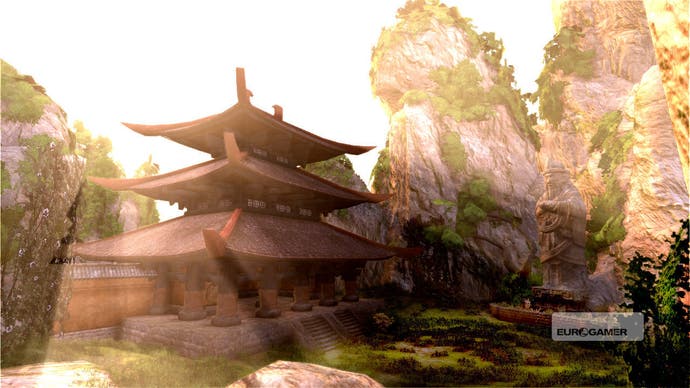Age of Conan: Rise of the Godslayer
Good God.
You arrive not at the heart of an unknown village, but rather to the smoking ruins of the trade caravan on which you were travelling, which was attacked by barbarians almost within sight of the gates to your homeland. There's a real sense that the story which you began in Tortage is continuing - exactly the sense which the game previously lacked.
As new quests take you further afield in the zone, you pick up strands of further interconnected stories. The one downside is that, while there's lots of interesting lore in the region, it's hardly a major departure visually - rocky steppes are familiar territory for Conan, and although the Mongolian influences are novel, it's a fairly homogeneous region, overall.
The far border of the zone is defined by the Great Wall, which looms over the region from its Eastern end, and it's beyond that wall that the second part of Godslayer's content is located: Khitai itself, a collection of zones influenced by the landscape, architecture and mythology of East Asia, especially Korea and Imperial China, although hints of cultures as diverse as Japan, Thailand and Cambodia all make an appearance in the game's luscious artwork. These zones are exclusively for level 80 players, and represent a truly vast expansion of Age of Conan's endgame.

Unusually, Funcom has opted not to expand the level cap beyond 80. Despite this, there's a distinct difficulty curve to the four new level 80 zones, starting off in Northern Grasslands, just beyond the Great Wall, and reaching a peak in the jungle zone of Paikang, far off on the eastern coast. In fact, by the time you're exploring Paikang's broken highways and suspicious jungle temples, you'll be fighting level 85 enemies - but your own level won't have budged an inch.
If it's a decision likely to throw newcomers - as, indeed, will the rather unforgiving difficulty of the level 80 Khitai regions, right from the very outset - it's one which has resonated with the game's players, who opposed the idea of a rise in the level cap. Instead, Funcom has adopted a middle ground, creating a new Alternate Advancement system which allows players to develop their characters without splitting the player-base or rendering the old level 80 content irrelevant.
Alternate Advancement is based on acquiring XP either through PvE or PvP, and then converting it into points which can be spent on "perks". There's a clear division between the two styles of play; PvE points are spent on PvE perks, PvP points buy you advantages against your fellow players. You earn the relevant XP through a whole host of actions, but it'll take you a while to earn the points required for high-end perks. However, in a nod to EVE Online, it's also possible to train perks one at a time by investing time in them, in which case they'll continue to train even when you're offline.

The other twist to the Alternate Advancement system is that you'll need to equip the majority of perks you train in order for them to take effect - and you only have a limited number of perk slots available. The consequences are far-reaching. In essence, five levels of character advancement have been replaced with an extremely user-configurable set of bonuses, meaning that there'll be more difference than ever before between level 80 characters, even of the same class.
It's not quite reaching the level of user customisation seen in something like Guild Wars, but as an exercise in putting clear water between Age of Conan and other MMOs, and emphasising Conan's long-standing focus on player skill, it's a pretty solid statement of intent.



